As we all know, that Windows Movie Maker was one of the most legendary free programs for editing videos on Windows for the longest time. Obviously this was mostly due to the fact that it came installed with every older version of Windows. The perks of the program weren’t just that it was free to use, but also its user-friendly interface.
Windows Movie Maker is a fan favorite due to its simplicity and partly the nostalgia factor too. However, sadly the software is no longer available, as its support has been seized by Microsoft. Other more popular video editors like Adobe Premiere and Sony Vegas are the new norm, but they aren’t free. In fact, they are very expensive. Thankfully there are tons of free alternatives for all skill levels and needs.
In this article we will go through the best free video editor alternatives and showcase their best features and reasoning on why you might want to use them. These video editors are not listed in no particular order and they were all personally tested by us to make sure they live up to their reputation.
Windows Video Editor
Let us start the list off with the Windows Video Editor. You might not even know about the existence of this app as it is not showcased in the same way as Movie Maker used to be. In fact, the whole Video Editor app is hidden inside the Photos app for some reason.
The Video Editor app comes pre-installed with the Windows 10 operating system and it’s completely free. In order to try out the native editor, all you need to do is open up your start menu and type in Video Editor. You will be greeted with a modern, sleek user-interface and a bunch of very clear-cut buttons and settings.
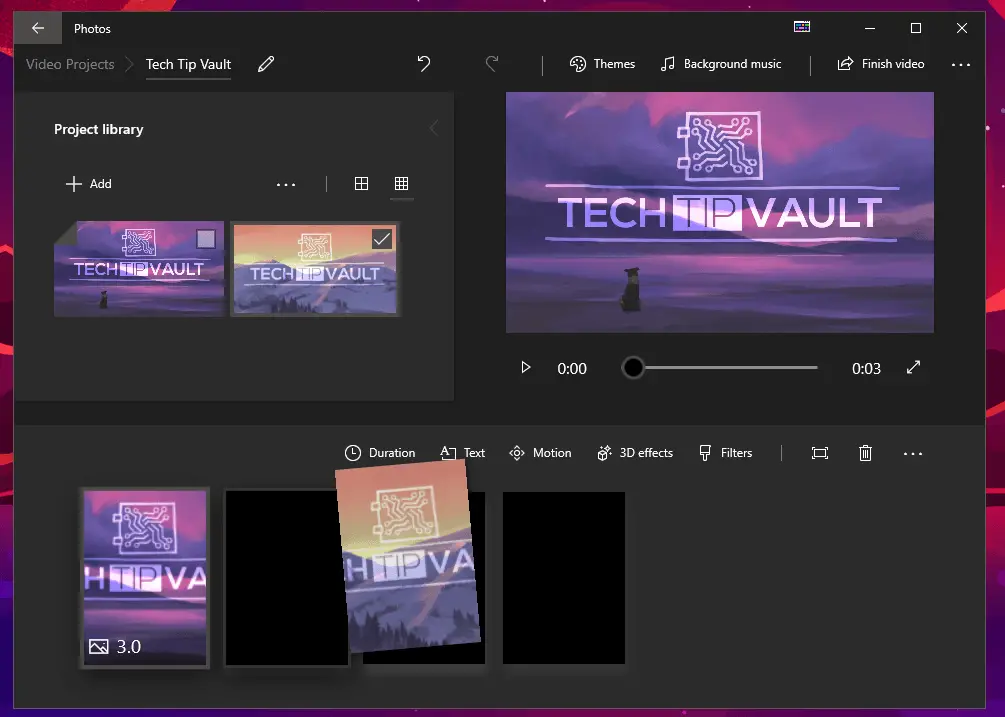
There is a surprisingly large variety of things you can do with the video editor, way more than the original Movie Maker ever provided. The first thing you will notice is the Project library which allows you to add photos and videos to be used in your project. You can simply drag and drop them into the timeline to add them in.
You can add custom audio and music as well as sync photos or videos to your music automatically. Other than that, there aren’t much other choices when it comes to modifying audio levels or timings, so it ends up being fairly limited.
On the flip-side, adding visual effects into the video is very easy and you get tons of different options. You can add text with multiple font options as well as pre-made animations for them. For some reason, it is not possible to use the normal fonts found in Windows, probably for simplicity’s sake. You can add cool 3D video effects with a few simple clicks as well, which can add a very advanced look into specific scenarios.
The Windows Video Editor even has color correction presets called Themes, which allow you to change the color scheme of your video with a single click. Some of the options can make a huge difference in the mood of your video.
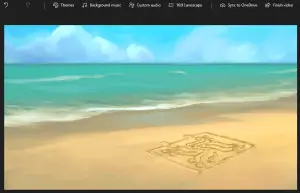
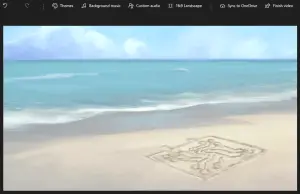
As for other settings beyond the editing itself, they are nearly non-existent. For any more advanced editing or rendering this is an issue, but they’re obviously left out to keep everything simple and easy to use for all users. You can only render with a few qualities and can’t change your frames per second or resolutions.
Other than that, you can also automatically sync your projects to a Microsoft OneDrive account, which is a feature you won’t find in any other video editing software, let alone a free one. This way you can also easily share your videos instantly with a few clicks, so you won’t need to upload them to YouTube where your friends won’t need to download them with separate tools.
Pros
Cons
VSDC Video Editor
The VSDC Video Editor is a fantastic free video editing software for Windows. It has tons of advanced features and is on a whole other level in comparison to Windows Movie Maker or Windows Video Editor. The caveat obviously being it has a higher learning curve and a more complex user interface. This means it’s designer for more advanced users.
The first thing you notice when you’re creating a new project with the VSDC Video Editor, is that it provides tons of quality options for video and audio. This is great to see in a free editor. You can edit in any custom resolution alongside any frame-rate. You can even customize your audio quality and metadata.
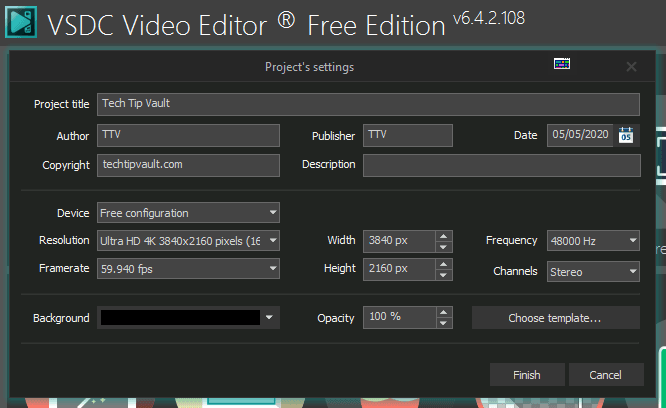
When it comes to the actual video editing itself, the user interface mimics the higher end editors pretty well. You get an insane amount of options and properties you can modify in a properties tab. In some cases you can find even more options to modify than most other paid video editors.
Alongside the media properties, you get a full track editor where you can split your video and audio into separate tracks. Sadly, a visible waveform on audio tracks is a premium feature, but it won’t be a huge deal unless you are trying to sync video to music.
Alongside the great track editor, you get tons of video effects and cropping tools, with blurring, color correction, masking and transforming. Some of these tools have the basic functionality available which is improved upon by the premium version of the software. However, the free version provides more than enough to get your effects down perfectly.
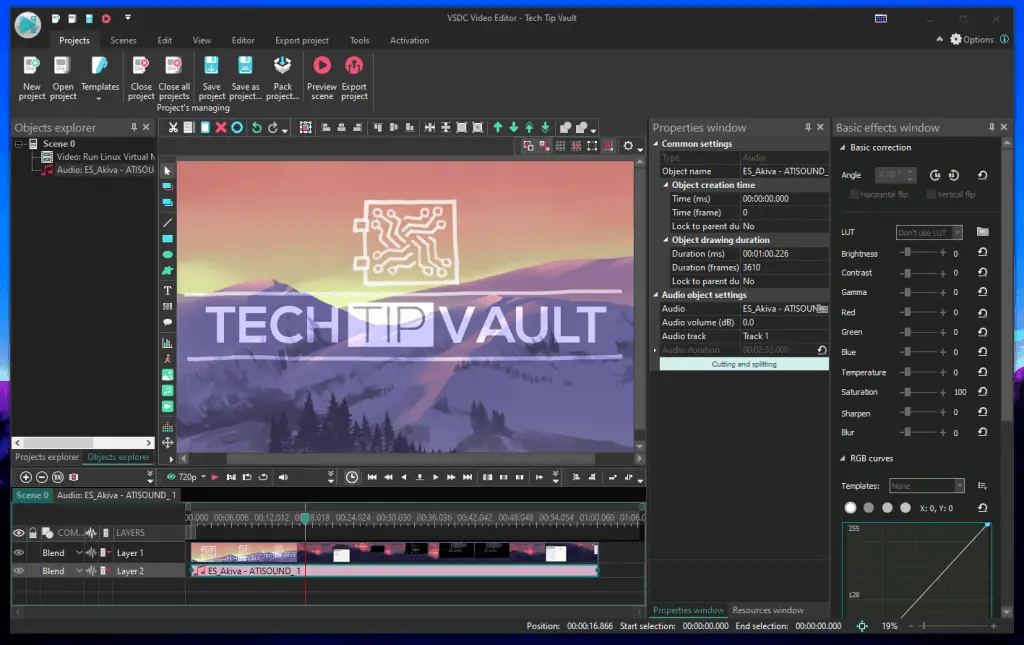
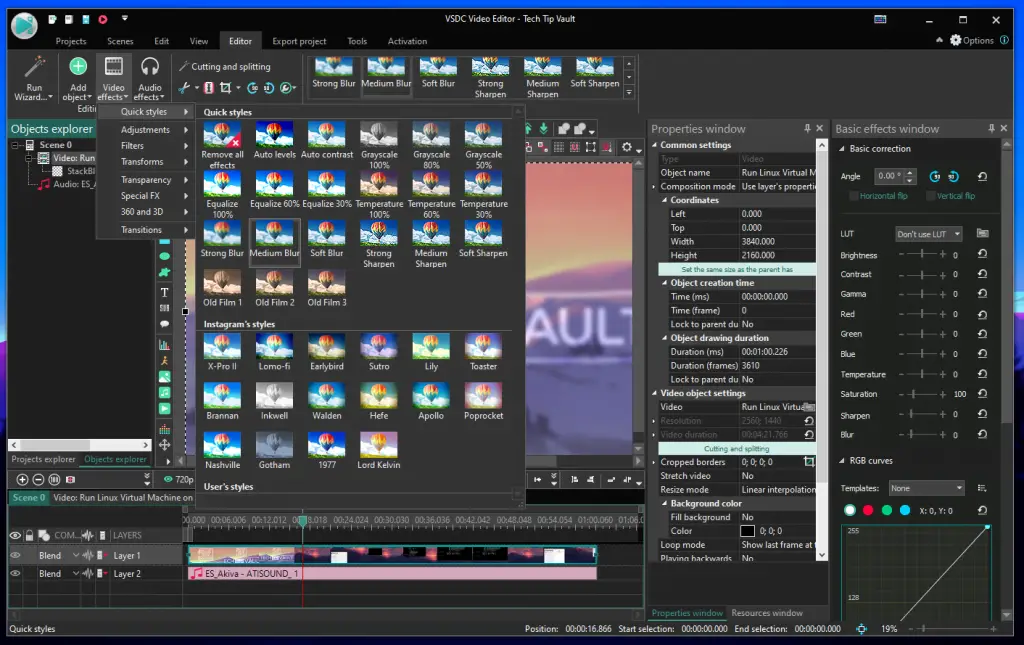
As for the export and rendering options, you can export to any major file format according to your original project settings. This allows for great freedom. However, every time you go to export your movie, you will be reminded to get the pro version to render faster. Thankfully, you can just ignore that reminder and keep rendering as normal.
Probably the main issue with the free version of this video editor is that it keeps reminding you to get the pro version to unlock some advanced settings. All-in-all, the pro version will only unlock additional options for some effects and hardware acceleration for rendering. Although the pro version is advertised to only cost $19.99, it seems to be a subscription and there is no information on their website on how often it recurs. For these reasons, we recommend you just stick to the free version of the VSDC Video Editor.
Another annoyance is the large amount of options in the Properties tab, as none of the functionality can be modified quickly in the track editor. This can be time consuming and makes it hard to find some less visible properties, but surely it will get easier with practice.
All in all, for the amazing price of free, the VSDC Video Editor is a very solid editing software and we recommend you try it out alongside all these other options. If you end up getting use out of it, why not support the developers buy buying the pro version as well.
Pros
Cons
Shotcut
Shotcut is one of the most popular free and open-source video editing programs. The layout is very similar to a lot of high high-end movie makers and it has tons of the same features as well.
When you first start up you will notice the freedom to choose any resolutions and framerates, which are set to automatically adjust to the first media file you add to the project.
Speaking of, adding media to the project is easy, but in order to add it to the timeline/media tracks, you need to select the media file by double-clicking on it, then dragging the video player down to the timeline. This was not very self explanatory but works well once you know the trick.
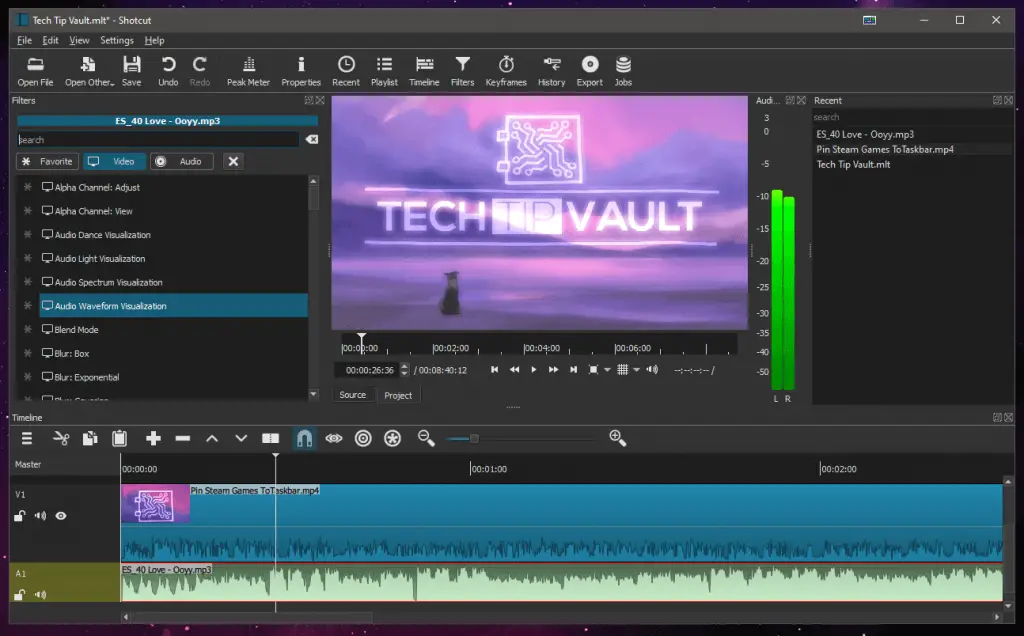
The track editor is great, you can easily add unlimited video and audio tracks as well as adjust individual volumes and visibility options. You can see very accurate wave-forms on each audio track and there are tons of tools to modify the tracks.
You can also add a huge amount of different video and audio effects, which are called Filters in Shotcut. They can be a bit confusing and non-intuitive to use, but the variety of options makes up for it. In the screenshot above, you can see the Glow video filter applied to the video clip.
The main downfall of Shotcut is definitely the non-intuitive user-interface. Using the filters and finding options is very complicated without proper tutorials and assistance.
Thankfully the software is being constantly updated and it has an amazing community forum and video tutorials to share tips and tricks among the users. You can find the basic video tutorials about the functionality on the Shotcut website. They should also give you a great idea on some of the features of the program.
All in all, Shotcut is a fantastic free video editor for Windows (also supports MacOS & Linux) and the amount of support it has makes it a great tool to learn. Although it has a somewhat steep learning curve, it’s definitely worth a shot if you’re looking to create great looking movies without spending a big buck on editing software.
Pros
Cons
Lightworks
Lightworks is one of the most popular video editors on this list, due to it being a professional grade video editor. Although it has a paid Pro version, the free version has most of the important and most useful features and tools available. Except for one crucial issue explained in the end…
Lightworks has been around for a long time and is being supported by a huge budget and an even larger community. Similar to Shotcut, it has a community forum where users discuss the features and help each other out. The Lightworks website also has a massive collection of tutorial videos covering every aspect of the software so that anyone has a chance to learn it.
When you first launch Lightworks, you will be greeted with a project hub where you can handle all your prior projects or set up a new one. Once you make a project, you are taken to a media importing library which gives you tons of tools to import any kind of files for your project and add them to the timeline.
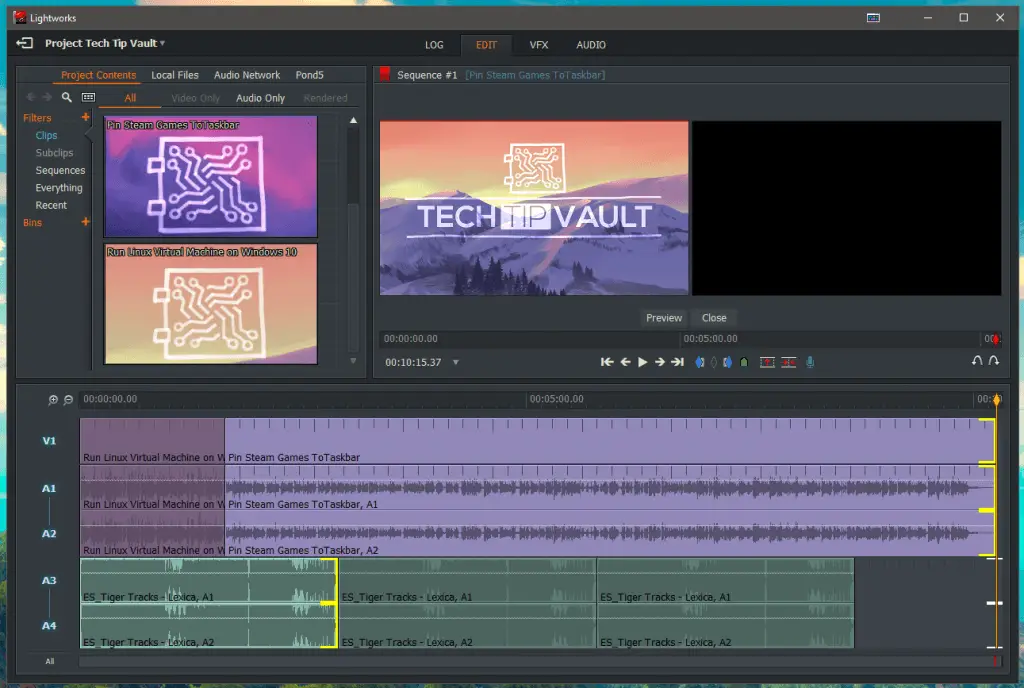
The best part about the Lightworks UI is not just the clear layout, but the fact that all the major parts of the editing process are separated into 4 separate tabs.
You can switch between your library, editor, VFX and audio tabs at the top at any time to get to a dedicated workspace for that specific aspect of your video. This makes it very simple to navigate through tons of tools without them getting too cluttered.
The track editor is pretty well laid out, but the main functionality is located below the video player, as you can use it to cut, insert and transform your clips. You can find about the basic workflow from this quick introductory tutorial video:
The video effects tab is also packed full of features to make your video look amazing. It can be very daunting to get used to at first, but after watching some tutorials, you will get the basic hang of things. It is very easy to miss-click or misplace effects as the key-frame timing interface is not very clear.
Also when you are working with the VFX, some effects don’t update in real-time when modifying it’s properties, which makes it harder to see what you’re doing. Even simple things like placing text in the correct position over time, is not a simple task at first.
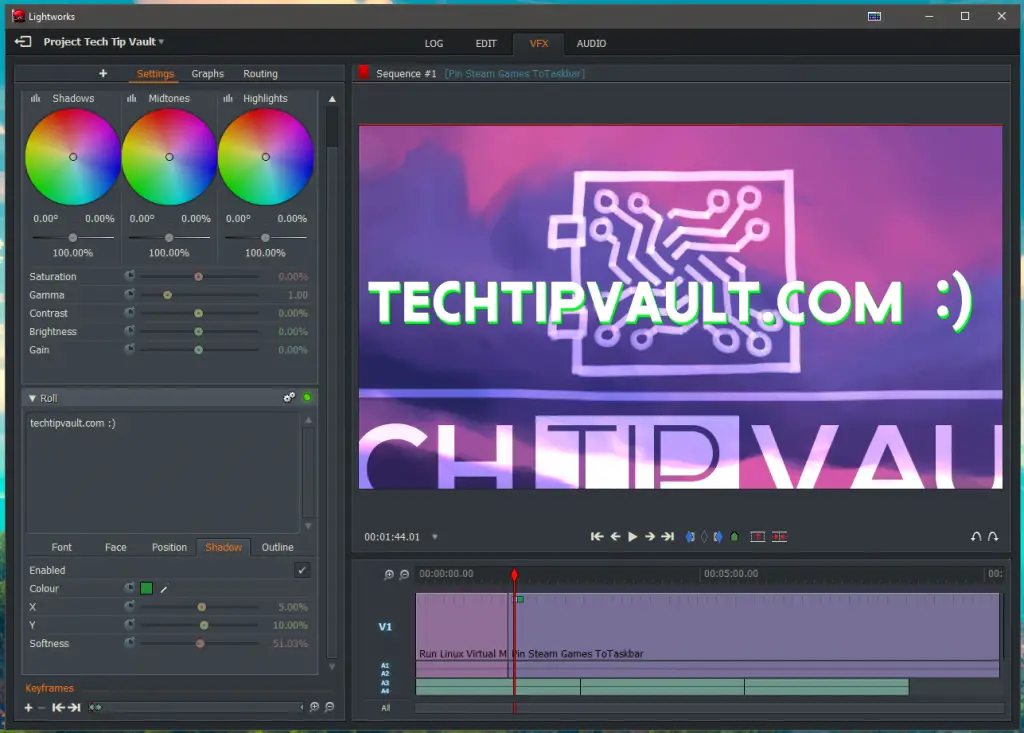
As you can see from the screenshot above, you have amazing control over anything you wish to add. You can even add a custom text and modify it’s font, color, animations and everything else you might think of.
These kinds of features rival the best of the best editing software and you get access to all of them in the Free version of Lightworks!
The main drawback with the free version of Lightworks (and it is a MAJOR DRAWBACK), is that you can only export videos in 720p (1280×720) quality. You can freely edit your videos in any quality, but unless you pay for the pro version, you can’t export in Full HD (1080p), let-alone in 4K resolutions.
In the age of Ultra-HD and widescreen monitors, uploading videos in 720p is not really the norm anymore. Obviously this is enough in some cases, but will be a breaking point for most users.
We must leave it up to you to decide if the rendering quality is worth the monthly payment of $20, as that really is the only problem with this free video editing software. Considering you can use Adobe Premiere Pro for $20 a month, it is hard to recommend Lightworks over it.
Pros
Cons
OpenShot Video Editor
The OpenShot Video Editor is an interesting alternative, reminiscent of Shotcut and the Windows Video Editor. It is definitely striving to be simple to use and easy to learn, while still maintaining some advanced features.
The first thing you notice is the sleek and clean UI, and the buttons are colorful and their functions are clear. This is quite refreshing, but it also highlights the fact that there are a lot less tools and buttons in comparison to more advanced video editing programs.
This brings us straight to the Timeline or track editor. It is probably the most unique feature of OpenShot. The track editor is very bare bones and doesn’t provide too much functionality, which is probably for the best if you are not looking to do any complicated overlays and cuts.
You do need to separate audio from a video by right-clicking on it if you want to add it to a separate track.
However what is different, is the fact that you can put video and audio on the same track, which also makes them multi-layered, as you can stack elements on top of each other on the same track.
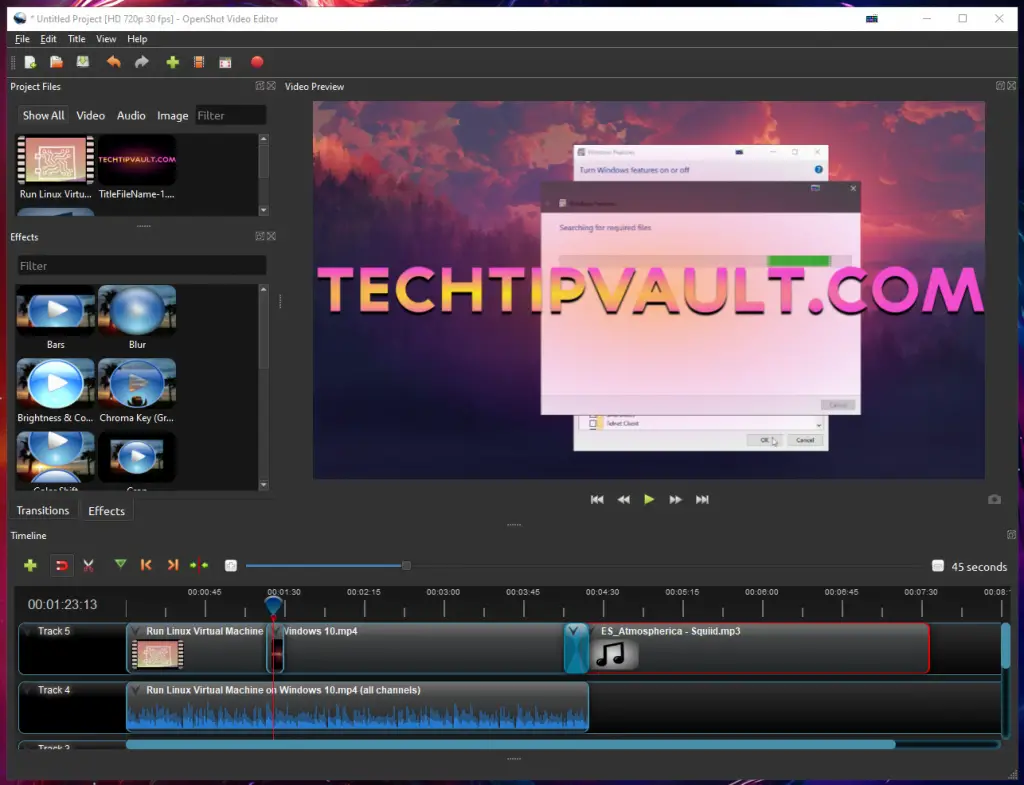
Multi format tracks can become confusing but can also be a big plus for some users. For example if you often end up using a lot of text or make subtitles, you don’t need to make tons of new tracks if you wish to overlap text and effects.
There are tons of video effects and transitions as well as titles/text options, but most of them are sub-par quality. For most use cases, however, you will definitely be able to make them work while still making the end product look reasonable.
As for the rendering, the OpenShot Video Editor provides all the formats and tools you need to render your videos in any quality and format. This is always a massive plus for a free video editor, especially after the Lightworks 720p fiasco.
Another noteworthy feature about OpenShot is not only that it’s fully open-source, but it also supports 70+ languages and documentation, make it it awesome for foreign audiences to pick up and start learning even if they don’t speak fluent English. This is a rarity in the freeware video editing market, and greatly appreciated.
Overall, we recommend you give OpenShot Video Editor a try, especially if you don’t need any very complex tools to clutter your user interface. The learning curve is very low and you can do a surprising amount of different things with this simple, but powerful video editor.
Pros
Cons
DaVinci Resolve
When it comes to DaVinci Resolve, it is good to note that it is even used for professional movie editing and post-processing by some companies. This video editor has a paid Studio version which add tons of professional grade features, but which are not necessary for normal operation.
Right off the bat, in order to download the software, you are prompted to enter your name, e-mail and even phone number in order to download the application. However, there doesn’t seem to be any e-mail confirmation or phone number checking so you don’t need to input your personal information if you so choose.
Another rough part is that the download size (at least for DaVinci Resolve 16) is 1.3 GB which is absolutely massive in comparison to all the other editors on this list. Obviously this is due to professional grade features and tools, but even then, it would be nice to be able to download some of them separately.
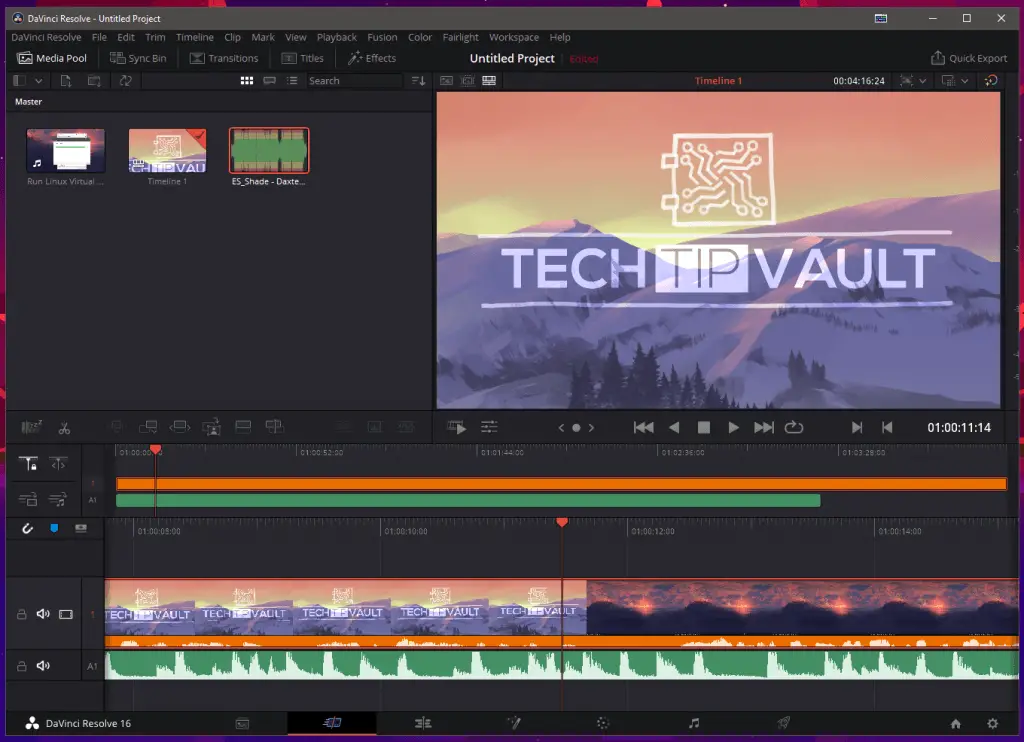
Once you’re done installing, you will be greeted with a beautiful, modern UI packed with different tools. The first thing you see is the media library where you can add your clips and move them to the timeline.
It is very handy as there is nothing extra shown, which is due to the fact that DaVinci Resolve uses tabs for separate views, very similar to Lightworks. Resolve has separate tabs for Media, Cutting, Editing, Fusion, Color, Audio and Exporting, which in itself shows how much features the software has.
The timeline in the editor has very clear tracks and scrubbing tools, all color coded for clarity. Again an issue arises that when there is so much to choose from and use, it’s going to take a lot of practice and reading up in order to learn all the tricks you need to know for smooth operation.
That leads us to one of the main downsides with Resolve, which is the very high learning curve, as there are so many complex professional grade features and tools that they can be very intimidating for casual and even experienced video editors.
When it come to effects and transitions, most of them are limited to the paid (studio) version of the software, which can be an issue if you like to work with blurs and other motion effects a lot. Basic things like normal transitions and text elements are usable even in the free edition.
Alongside VFX, the audio editing in DaVinci Resolve is on a hole other level. The possible audio modifiers and the entire editor tab provides tons of tools to make whatever modifications you need to your audio atmosphere.
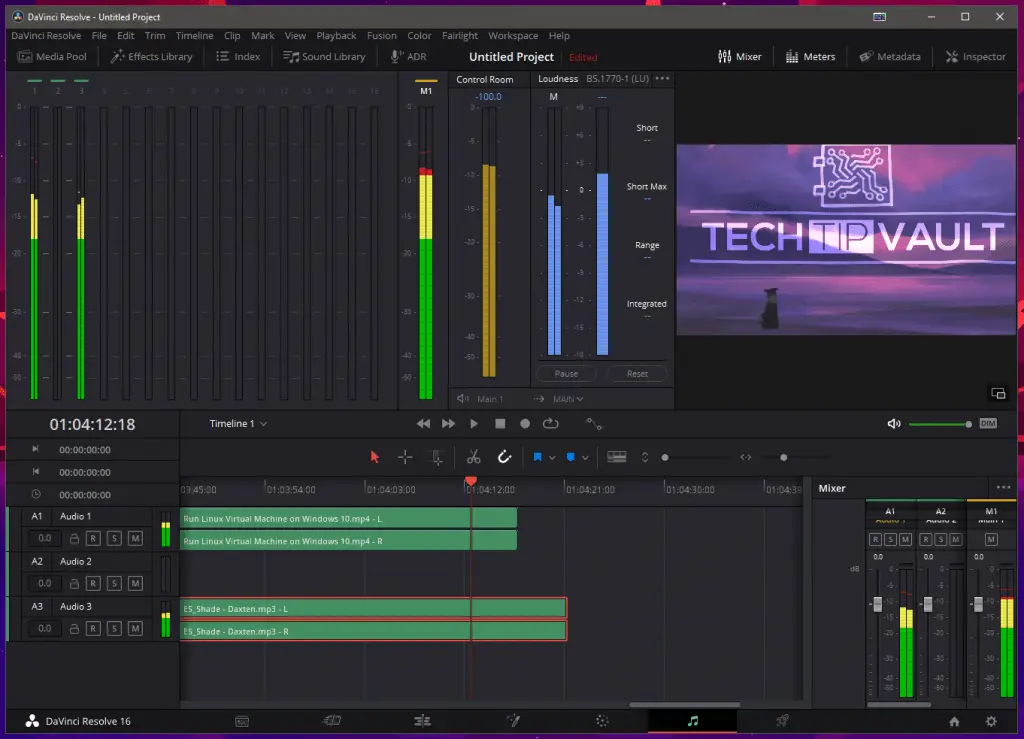
Finally, for the rendering options you have all the options you might need when it comes to resolution and framerate. You need to make sure you started your project with those settings though, as changing them later can be an issue. As an added bonus, you can even upload your final project directly to YouTube or a few other platforms.
Overall, it is clear that DaVinci Resolve is a professional video editing software and it definitely shows. It is clean and moderately simple to use at it’s core, but it has a lot of complex and advanced features which will take a lot of practice to get used to. You can find some of the tutorials and other material on the Blackmagic Design homepage.
Pros
Cons
HitFilm Express
HitFilm Express is another free version of a professional video editor which provides tons of features off the bat so you can definitely get all you need from it for free. As a sidenote, if we were to pick a free video editor to use from this list on a daily basis, it would most likely be HitFilm Express.
In order to download HitFilm Express, you will be guilt-tripped by a donation slider which you need to slide all the way to zero in order to get the download link. You also need to create a free account in order to download and activate the software.
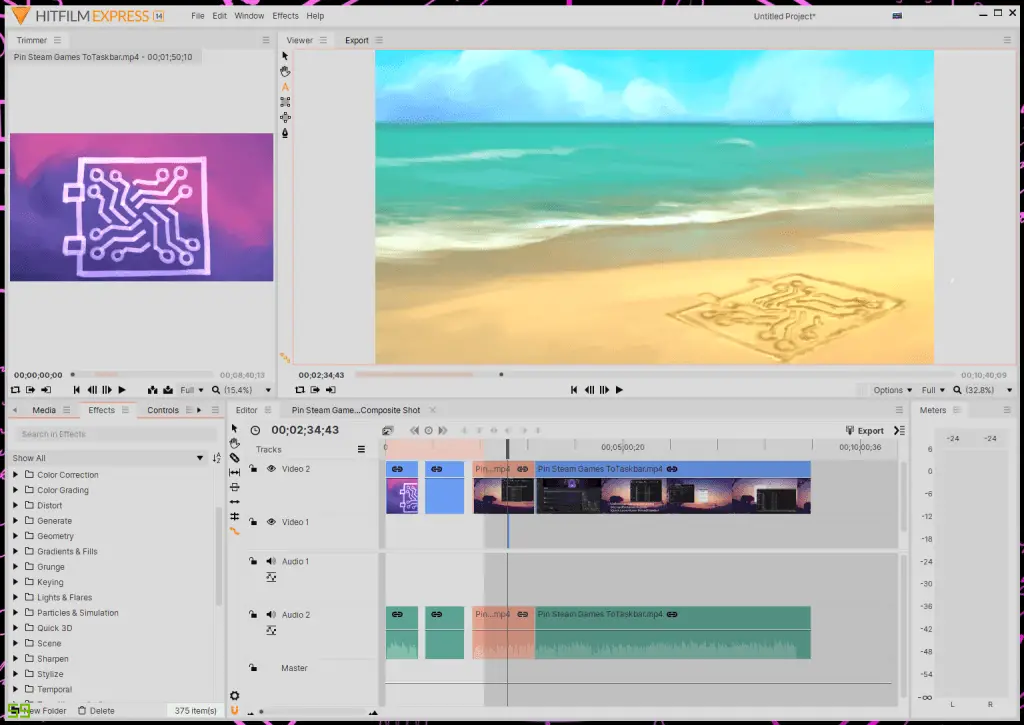
The user interface of HitFilm Express clearly takes inspiration from classic video editing software like Sony Vegas, which definitely hits home with me as I’ve used Sony Vegas 13 for many years.
The layout of all the controls is done in a smart separation of windows and tabs, keeping everything sorted.
You can edit and render in any resolutions and framerates which is always good to see. Once you import your footage, you can simply drag and drop them into the editor which will add them to a video or audio track. You can easily color-code any tracks to make everything clearer.
The track editor has all the tools you need to cut, split and move the clips around. Alongside the editor, you have different tabs for media settings, video effects and an audio mixer.
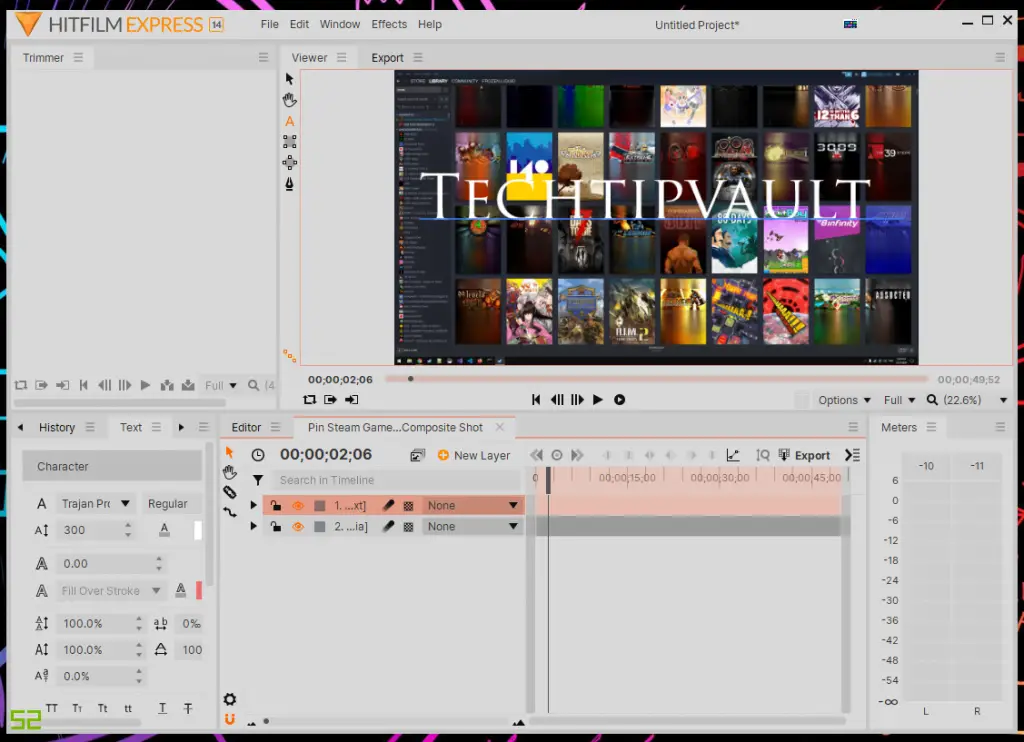
HitFilm Express comes packed with tons of effects and transitions, but applying them is not done in the old fashioned way. HitFilm uses a special mechanism called Composite Shots to allow for easy creation of complicated effects.
Composite shots basically allow you to stack text and effects on top of each other and then simply apply all of it on a single video track in the editor. This makes simple things like adding a simple blur more complicated, but it keeps the layout clean and makes it way easier to fine-tune single effects.
Although HitFilm Express has a lot of tools, effects and transitions, the best features require either the purchase of separate plugins or a license. Even the Dark Theme is hidden inside a 10 dollar starter add-on package.
All in all, this is one of the best free video editing software you can get currently, as it has very few issues and has tons of potential, while still being moderately simple to use and master.
Also the fact that you can buy specific advanced tools and features you need for lower cost, instead of buying a full license is very useful if you’re on a budget.
Pros
Cons
Ezvid
Ezvid is all about simplicity, and getting the work done the easy way. It is a completely free video editing software for Windows and is ran strictly by donations and two amazon affiliate banners at the bottom of the video editor UI.
The software comes bundled with a screen recorder as well as an audio recorder. These tools can be used directly from the editor.
The screen recorder can be activated with a single click and can be used to record your desktop or a game. The footage will be directly added to the video editor after the recording is stopped, which is a very cool feature, not available on any other video editing software out there. You can also record your face-cam and draw with a pen tool while recording.
The main caveat is that the software doesn’t record background audio for screen recordings and doesn’t even add audio tracks of any video clips you choose to import into the software. This means you can only add separate audio tracks or record voice over your video.
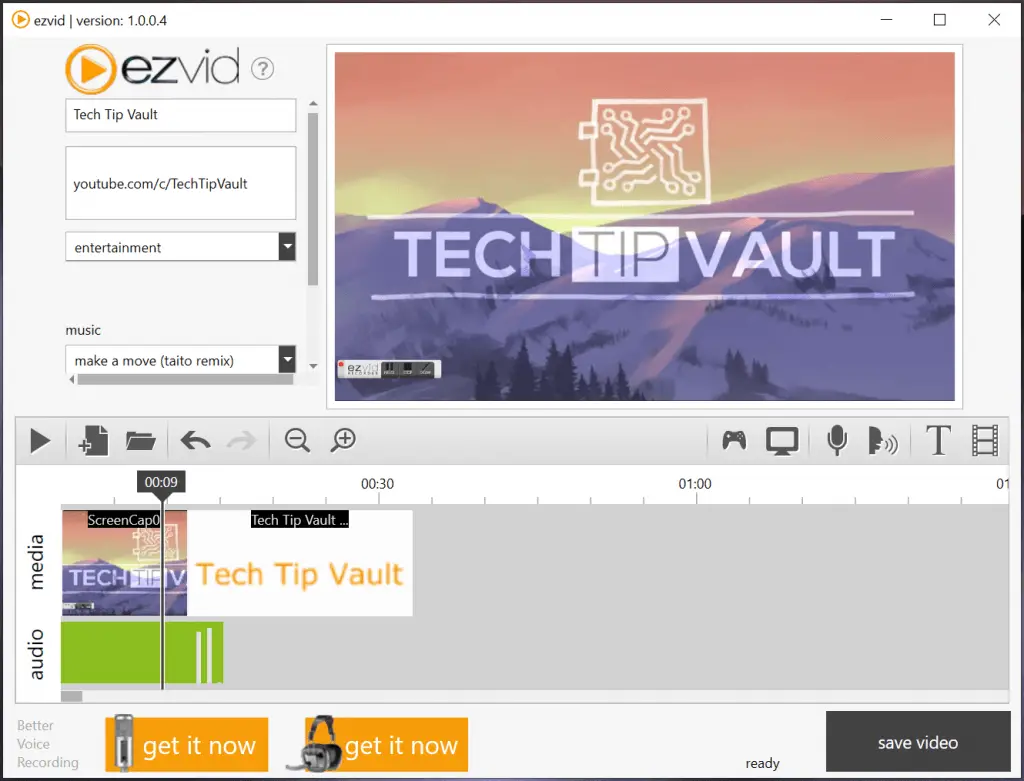
In its essence, the Ezvid video editor is extremely bare-bones and not meant for any advanced editing. It only features a single video and audio track and no real visual modification capabilities.
The software comes with a bunch of pre-loaded music you can use and even a voice synthesizer which will read out loud any text layers you decide to add. You can also add any image as a watermark to your videos with a single button.
In all honesty, the Ezvid video editor is only good for making tutorials or videos with voice-overs, as the screen recording feature is great and voice recording works well.
The recordings get added directly into the editor which makes the process fast and efficient. For any other type of video editing, this software won’t cut it and you are better off choosing on of the other alternatives on this list.
Pros
Cons
VideoLAN Movie Creator (VLMC)
This is an honorable mention, as VLMC is currently in development and promotes anyone to improve on its open-source code. You can check more about the progress of the project on the official VLC Media Player website.
VideoLAN Movie Creator is a free video editor for Windows, Linux and Mac promoted by the same people behind the famous VLC Media Player. The cool thing about this video editor software is that it’s fully open source and they’re inviting all interested parties from students to veteran developers to work on it.
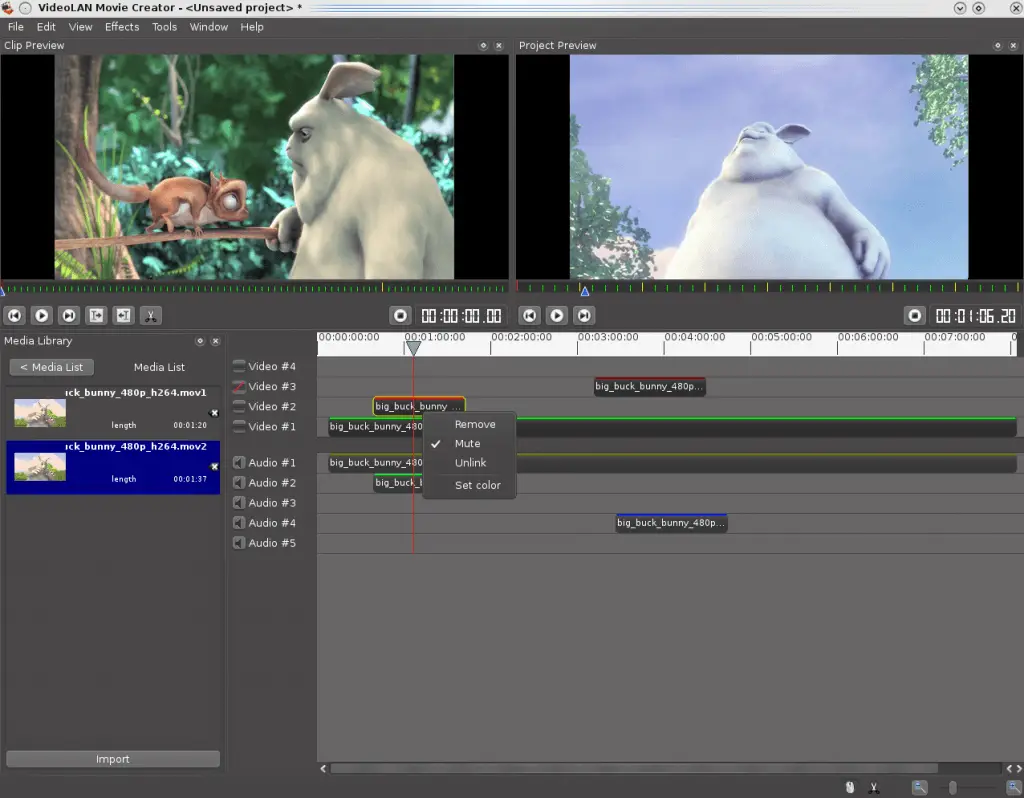
Due to it being developed by fans, means it will have infinite support and updates and since it’s a non-profit project, means it will become something huge. We highly recommend you keep an eye on the project and maybe even go contribute to the code. The VLMC will most likely be the next huge milestone in the video editing industry.


